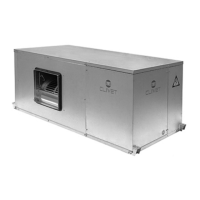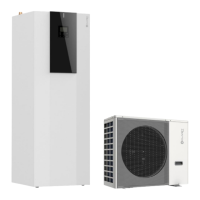21
9 - MAINTENANCE
!
9.1 GENERALITY
Maintenance must be carried out authorised after-sales
assistance centres or by specialised personnel.
Maintenance allows:
• maintaining the unit efficient
• reduce deterioration speed to which each equipment is
subject in time
• collect information and data to understand the efficiency
state of the unit and prevent possible faults
Frequency of the inspections must be at least six-monthly
However, frequency depends on the type of use.
• heavy (continuous or highly intermittent, near to operation
limits, etc.)
• critical (essential service).
9.2 FREQUENCY OF INTERVENTIONS
9.3 MACHINE SCHEDULE
Foresee a machine schedule to keep trace of the
interventions made on the unit.
In this way, it will be easier to adequately schedule the various
interventions and facilitate any troubleshooting.
On the schedule note:
• date
• type of intervention made
• description of intervention
• measurements taken, etc. .
If foreseen a long period of inactivity:
• disconnect voltage to avoid electric risks or damages
following lightning
• prevent the risk of freezing (empty or glycol the sections of
the system exposed to negative temperatures, keep any
antifreeze heaters powered)
It is advised that start-up after a period of inactivity be carried
out by a qualified technician, in particular after seasonal stops
or for seasonal switch-over.
Upon start-up, follow that indicated in the START-UP section.
Plan in advance the technician intervention to prevent
misunderstandings and be able to use the system when
required
9.4 STAND-BY
i
i
It is very important for the exchanger to be able to provide the
maximum thermal exchange. Therefore, it is essential for the
inner surfaces to be clean of dirt and incrustations.
Periodically check the difference between the temperature of
the supply water and the condensation temperature. If the
difference is greater than 8 °C – 10 ° C it is advisable to clean
the exchanger.
The clearing must be effected :
• With circulation opposite to the usual one
• With a speed at least 1,5 times higher than the nominal
one
• With an appropriate product moderately acid (95% water +
5% phosphoric acid
• After the cleaning rince with water to inhibe the detergent
rests.
9.5 WATER EXCHANGER
9.6 INTERNAL AIR COIL
Accidental contact with the fins of the exchanger may cause
small cuts. When performing the following steps, use
protective gloves.
The finned surfaces of the cooling coils and especially the
condensation collection trays are the places where micro-
organisms and moulds most easily flourish. It is therefore
very important to clean regularly with suitable detergents and
disinfect with appropriate products as necessary.
Dust and deposits could cause obstructions .
In the tank can also proliferate microorganisms and mold.
Very important to provide for a periodic cleaning with
appropriate detergents and in case to a disinfection with
sanitizing products.
Clean the tank, pour some water into the tank and check
water flows normally.
9.7 CONDENSATE DISCHARGE

